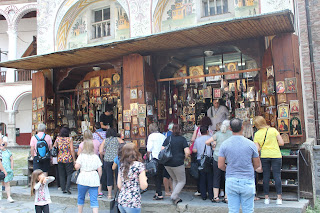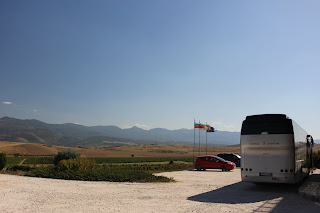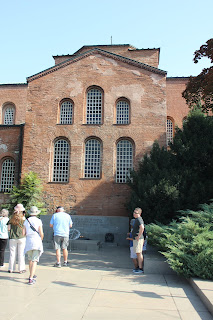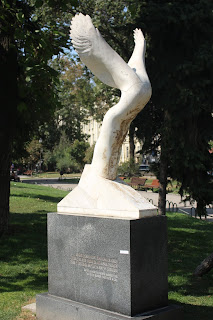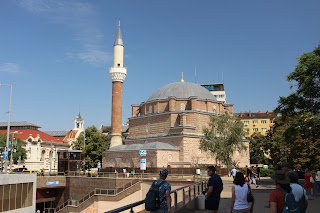On Monday, August 26th, we put on our audio sets and Stefan took us on a walking tour of downtown Sofia. First we met (a statue of) St. Kliment of Ohrid, after whom the University is named. He is very important because after his teachers, Saints Cyril and Methodius, invented the Glagolitic script in order to write Slavic languages, Kliment made it more useful, turning it into Cyrillic, which the Bulgarians adopted long before the Russians did.
Then we walked over to the Cathedral of St. Alexander Nevsky, built to honor the Russians who helped Bulgaria achieve independence in 1877-78, after five centuries of Ottoman rule. Nevsky is definitely not a Roman Catholic saint (see Sergei Eisenstein's famous movie about him, with music by Prokofiev, where he defeats the crusading Catholic order of Teutonic Knights in a battle on an icy lake). It is built in Byzantine style, by a Russian architect.
Then we went to the monument of the Unknown Soldier, next to the 6th-century St. Sophia church. It was guarded by a bronze lion, originally planned to be one of two--the lion is the Bulgarian heraldic animal--but the Communist regime was not happy about this lion. The sculptor had intentionally made it sad and starving--he saw nothing triumphant about Bulgarian involvement in the two world wars. The sculpture was refused and wasn't put in place until the fall of Communism.
Next, Stefan took us to three stone slabs, where he told us the very moving story of how the Bulgarian people came together to prevent any of their 49,000 Jews from being sent to Nazi extermination camps.
Nearby was a strange, wild-eyed statue of King Samuil, one of the last kings before the Byzantines conquered the first Bulgarian kingdom in the eleventh century.
We went on to the Russian church--the church built by the Russians for the Russians, as opposed to being built by the Russians for the Bulgarians.
Then we saw the "yellow brick road" (donated by Austro-Hungarian Emperor Franz Josef after he had experienced Sofia's muddy streets), the National Theater, the City Garden, the Presidency Building, with its costumed guards, the Archeological Museum, the National Assembly Building, and below-ground archeological ruins of ancient Roman Serdica. The relatively new statue of "St. Sophia" (Holy Wisdom) is on a pedestal that used to belong to Georgi Dimitrov, the first leader of Communist Bulgaria. We passed the Banya Bashi Mosque, the only one currently operating in Sofia, and ended up visiting the Sofia Synagogue, built in 1909--impressive, though not as big as the one in Budapest. It has the largest chandelier in Bulgaria.
Stefan dismissed us to find lunch on our own. We tried one of his suggestions, Mi Casa (not actually a Spanish restaurant!)--good. Then we went back to the hotel and rested. Mary Joy was coming down with a cold, and we were still somewhat jet-lagged.
After a late-afternoon presentation by a local economist-politician (not far-right, but clearly in favor of small government--he thought that the current center-right government was too far left, and made some comments as to the disincentives involved in the social safety net that former U.S. Speaker Paul Ryan would no doubt approve of). The next day, Stefan mentioned, in passing, that he and his economist friend did not always agree.
I asked Stefan for a suggestion for dinner that would be nearby and relatively light, He suggested Raffy Bar and Gelato. It had a youth vibe similar to the Rainbow Factory 2 and the food was good.




